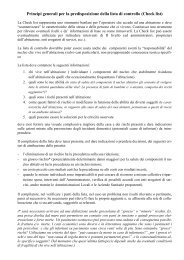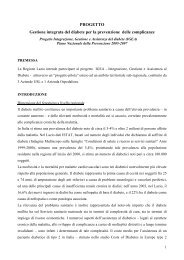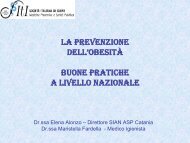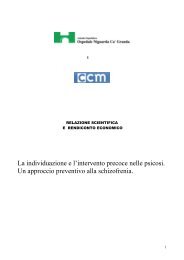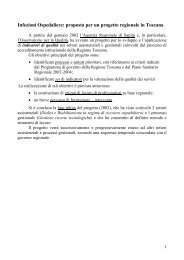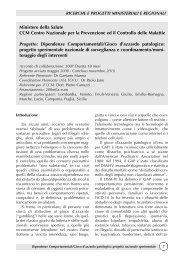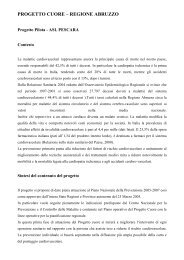Gaining health : analysis of policy development in European ...
Gaining health : analysis of policy development in European ...
Gaining health : analysis of policy development in European ...
Create successful ePaper yourself
Turn your PDF publications into a flip-book with our unique Google optimized e-Paper software.
Chapter 4<br />
76<br />
The low cardiovascular mortality and morbidity have been<br />
studied by a number <strong>of</strong> researchers. The so-called “French<br />
paradox”, first described by Samuel Black <strong>in</strong> 1819, refers<br />
to the fact that people <strong>in</strong> France have a low <strong>in</strong>cidence <strong>of</strong><br />
coronary heart disease, despite their diet be<strong>in</strong>g rich <strong>in</strong><br />
saturated fats. It is believed that France’s relatively high red<br />
w<strong>in</strong>e consumption is a primary reason for this paradox but<br />
also that nutrition, the moderate consumption <strong>of</strong> beer and<br />
distilled spirits, the regularity and quality <strong>of</strong> physical activity,<br />
the climate and many other factors may play a role (4).<br />
1.3. The ma<strong>in</strong> features <strong>of</strong> the <strong>health</strong> system<br />
The French <strong>health</strong> system has a good reputation. In fact,<br />
The world <strong>health</strong> report 2000 ranked France as hav<strong>in</strong>g the<br />
best <strong>health</strong> care system <strong>in</strong> the world (5). The positive<br />
characteristics are the high level <strong>of</strong> access to <strong>health</strong> care<br />
and service utilization, an abundant availability <strong>of</strong> choice<br />
without any significant wait<strong>in</strong>g lists and the high level <strong>of</strong> life<br />
expectancy.<br />
The French <strong>health</strong> system is based on a national social<br />
<strong>in</strong>surance system complemented by elements <strong>of</strong> tax-based<br />
f<strong>in</strong>anc<strong>in</strong>g and complementary voluntary <strong>health</strong> <strong>in</strong>surance. 3<br />
The <strong>health</strong> system is regulated by the state and the statutory<br />
<strong>health</strong> <strong>in</strong>surance funds. The state sets the ceil<strong>in</strong>g for<br />
<strong>health</strong> <strong>in</strong>surance spend<strong>in</strong>g, approves a report on <strong>health</strong> and<br />
social security trends, and amends benefits and regulation.<br />
There are three ma<strong>in</strong> schemes with<strong>in</strong> the statutory <strong>health</strong><br />
<strong>in</strong>surance system: the general scheme cover<strong>in</strong>g about 84%<br />
<strong>of</strong> the population (employees <strong>in</strong> commerce and <strong>in</strong>dustry<br />
and their families); the agricultural scheme cover<strong>in</strong>g farmers<br />
and their families (7.2% <strong>of</strong> the population); and the scheme<br />
for self-employed people cover<strong>in</strong>g 5% <strong>of</strong> the population.<br />
3<br />
The general pr<strong>in</strong>ciple is that <strong>health</strong> care costs are reimbursed by the<br />
statutory <strong>health</strong> <strong>in</strong>surance system. However, there is usually a discrepancy<br />
between the actual amount paid by patients and the amount they<br />
are reimbursed by their <strong>health</strong> <strong>in</strong>surance fund. A complementary <strong>health</strong><br />
<strong>in</strong>surance scheme can be subscribed to on a voluntary basis to cover this<br />
discrepancy.<br />
In 2004, an <strong>in</strong>surance fund was established specifically for<br />
dependent elderly people.<br />
In January 2000, universal <strong>health</strong> coverage was <strong>in</strong>troduced,<br />
<strong>in</strong>troduc<strong>in</strong>g the right to statutory <strong>health</strong> <strong>in</strong>surance coverage<br />
on the basis <strong>of</strong> residence <strong>in</strong> France. Furthermore, those<br />
whose <strong>in</strong>come is below a certa<strong>in</strong> level (currently 1.8% <strong>of</strong><br />
the population) are entitled to free <strong>health</strong> care.<br />
In 2002, total expenditure on <strong>health</strong> care was estimated<br />
at 9.7% <strong>of</strong> GDP, <strong>of</strong> which 7.4% was public and 2.3% private<br />
expenditure (6). Expenditure on prevention is estimated at<br />
2.4% <strong>of</strong> all <strong>health</strong> costs (4).<br />
There are around 10 physicians and nurses per 1000<br />
<strong>in</strong>habitants, which is above the EU average. The number <strong>of</strong><br />
nurses is double the number <strong>of</strong> doctors, though this favourable<br />
proportion has slightly changed recently (4).<br />
2. France’s approach to develop<strong>in</strong>g policies<br />
to tackle NCD<br />
A special historical characteristic <strong>of</strong> the French public <strong>health</strong><br />
system is that the all-embrac<strong>in</strong>g term noncommunicable<br />
diseases is not widely used. Public <strong>health</strong> experts, <strong>policy</strong>makers,<br />
adm<strong>in</strong>istrators and practitioners prefer to refer<br />
to the <strong>in</strong>dividual conditions rather than refer to them as<br />
a category. This is ma<strong>in</strong>ly because <strong>of</strong> the strong traditions<br />
and identity <strong>of</strong> each field and the existence <strong>of</strong> separate,<br />
well-established public <strong>health</strong> work<strong>in</strong>g groups with different<br />
<strong>in</strong>terests.<br />
The major <strong>in</strong>strument <strong>of</strong> strategy is the Public Health Act <strong>of</strong><br />
2004. Although the primary role <strong>of</strong> the Act was to reorganize<br />
and restructure the decision-mak<strong>in</strong>g and adm<strong>in</strong>istrative<br />
system related to public <strong>health</strong>, the Act can be considered<br />
as a broad, complementary general framework for the<br />
Case studies: <strong>policy</strong> <strong>development</strong> <strong>in</strong> countries for tackl<strong>in</strong>g noncommunicable diseases



